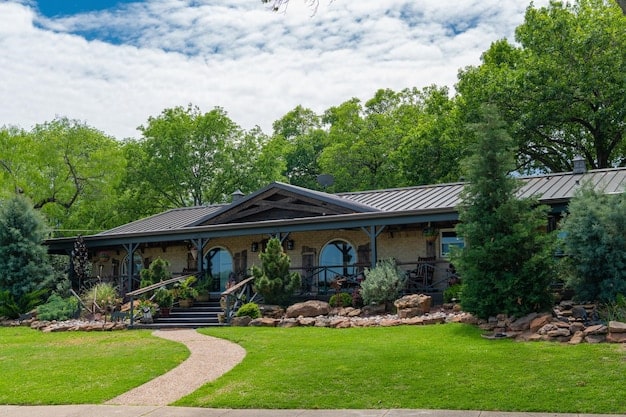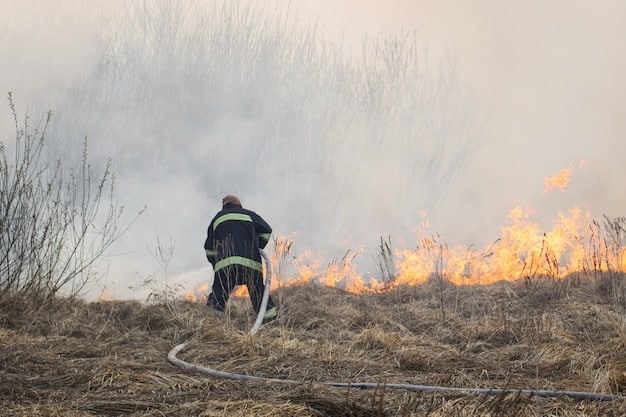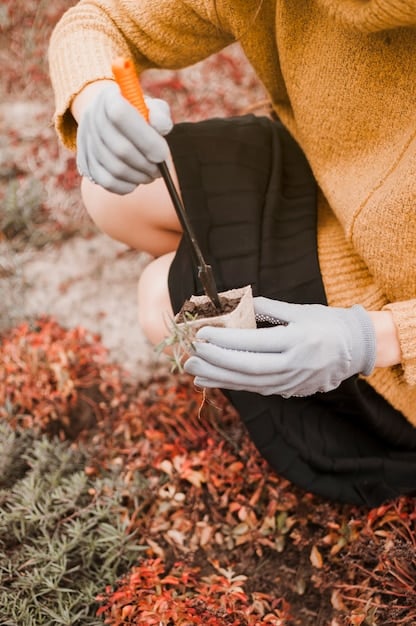Wildfire Prevention: Protect Your Home & Community This Summer

Wildfire prevention involves simple, yet crucial steps like maintaining defensible space around your home, using fire-resistant landscaping, and staying informed about local fire weather conditions to protect your property and community during the summer months.
Summer brings sunshine and outdoor fun, but it also marks the start of wildfire season. Protecting your home and community from wildfires requires proactive measures, and this article outlines simple yet effective steps for wildfire prevention: simple steps to protect your home and community this summer.
Understanding Wildfire Risk and Its Impact
Wildfires pose a significant threat across the United States, especially during the dry summer months. Understanding the factors that contribute to wildfire risk is the first step in effective prevention. Awareness helps communities take informed action to protect homes and lives.
Several elements influence wildfire behavior and spread. Factors like temperature, wind speed, and humidity play a critical role in determining how easily a fire can ignite and propagate. Additionally, vegetation type and density are crucial determinants, with dry grasses and dense forests presenting higher risks.
The Role of Weather Conditions
Weather conditions significantly influence wildfire risk. Hot, dry, and windy weather creates ideal conditions for fires to start and spread rapidly. Understanding daily fire weather forecasts is essential for staying informed and taking necessary precautions.
Vegetation as Fuel
Vegetation serves as fuel for wildfires, with different types burning at varying intensities. Dry grasses, brush, and trees all contribute to the spread of flames. Managing vegetation around homes and communities is a key aspect of wildfire prevention.

Wildfires can have devastating consequences, impacting not only homes and properties but also the environment and human health. Long-term effects on ecosystems and air quality underscore the importance of preventing these disasters.
- Property Damage: Wildfires can destroy homes, businesses, and infrastructure, leading to significant financial losses.
- Environmental Impact: Wildfires can damage forests, watersheds, and wildlife habitats, disrupting ecosystems.
- Health Risks: Smoke from wildfires can cause respiratory problems, especially for vulnerable populations.
Understanding the science behind wildfires and the impacts they have on communities and the environment underscores the importance of acting preventatively. Knowledge and preparation can significantly reduce the damage caused by these disasters.
Creating Defensible Space Around Your Home
Defensible space is the buffer zone between your home and surrounding vegetation. This area is designed to slow or stop the spread of wildfire and protect your home from direct flame contact or radiant heat. Creating and maintaining defensible space is one of the most effective steps you can take.
The concept of defensible space involves managing vegetation in specific zones around your home. The size and intensity of vegetation management depend on factors such as the slope of the land, the type of vegetation, and local fire codes. Knowing these factors is crucial for effective implementation.
Zone 1: Immediate Surroundings
Zone 1 extends approximately 30 feet from your home. In this zone, it’s crucial to remove all dead vegetation, leaves, and pine needles from under decks, porches, and around the foundation. Clearing this area reduces the risk of embers igniting the structure itself.
Zone 2: Reduced Fuel Zone
Zone 2 extends from 30 to 100 feet from your home. Here, vegetation should be thinned and spaced to reduce fire intensity. Remove lower tree branches, mow grasses, and create fuel breaks to slow the spread of fire. Regular maintenance is key to continued protection.

Regular maintenance is critical to ensuring the effectiveness of defensible space. Remove accumulated debris, prune vegetation, and monitor the area for any new growth that could pose a fire risk. Consistent upkeep ensures your defensible space remains effective throughout the wildfire season.
- Regular Clearing: Schedule regular clearing of dead leaves, pine needles, and other flammable materials.
- Pruning: Prune trees and shrubs to remove low-hanging branches that can carry fire to the canopy.
- Inspection: Inspect your defensible space regularly for any signs of new growth or accumulated debris.
Establishing and maintaining defensible space is not a one-time activity but an ongoing commitment. Consistent effort will help protect your home from the threat of wildfires, creating a safer environment for you and your family.
Choosing Fire-Resistant Landscaping
The type of landscaping you choose can significantly impact the vulnerability of your home to wildfires. Fire-resistant landscaping involves selecting and arranging plants and materials that are less likely to ignite or spread flames, providing an additional layer of protection.
Selecting fire-resistant plants involves choosing species that are less prone to burning. These plants typically have high moisture content, low resin content, and open growth habits, reducing their flammability. Incorporating these plants into your landscape can significantly reduce fire risk.
Selecting the Right Plants
Choose plants with high moisture content, such as succulents, ground covers, and certain deciduous trees. These species are less likely to ignite quickly and can help slow the spread of fire. Consult local nurseries or fire experts for recommendations suitable for your region.
Arranging Your Landscape
Proper arrangement of plants can also reduce fire risk. Space plants adequately to prevent fire from spreading easily from one plant to another. Create fuel breaks by using non-combustible materials like gravel or rock in strategic areas.
Non-combustible materials, such as gravel, rock, pavers, and concrete, can be used to create fire-resistant pathways, patios, and borders around your home. These materials do not burn and can help block the spread of fire. Incorporating them into your landscape design adds an extra layer of protection.
- Gravel Pathways: Use gravel pathways to create breaks between vegetation and your home.
- Rock Borders: Create rock borders around planting beds to prevent fire from spreading.
- Concrete Patios: Install concrete patios or walkways to provide a non-combustible area around your home.
Designing and maintaining fire-resistant landscaping involves thoughtful planning and consistent effort. By selecting the right plants, arranging them strategically, and incorporating non-combustible materials, you can create a beautiful and fire-safe environment around your home.
Home Hardening: Strengthening Your House Against Wildfire
Home hardening involves making structural improvements to your house to increase its resistance to wildfires. Embers and radiant heat are two of the primary ways wildfires damage or destroy homes, so addressing these vulnerabilities is crucial for effective protection.
The roof is one of the most vulnerable parts of a home during a wildfire. Embers can easily land on the roof and ignite combustible materials, leading to a fire. Upgrading to a fire-resistant roofing material is one of the most effective steps you can take to protect your home.
Roofing Materials
Choose roofing materials such as tile, metal, or asphalt shingles that have a Class A fire rating. These materials are less likely to ignite and can provide significant protection against embers and flames.
Maintaining Your Roof
Regularly clean your roof to remove leaves, pine needles, and other debris that can accumulate and become a fire hazard. Keeping your roof clear reduces the risk of embers igniting combustible materials.
Vents are another vulnerable area where embers can enter your home. Embers can be blown into vents and ignite combustible materials inside the attic or crawl space, leading to a fire. Protecting vents with fine mesh screens can help prevent ember intrusion.
- Install Mesh Screens: Cover all vents with metal mesh screens that have openings no larger than 1/8 inch.
- Check Regularly: Inspect vent screens regularly to ensure they are in good condition and free of debris.
- Consider Enclosed Eaves: Enclose eaves to prevent embers from entering these areas.
Taking steps to harden your home against wildfires can significantly increase its chances of survival. By upgrading roofing materials, protecting vents, and maintaining your property, you can create a more fire-resistant structure, safeguarding your home and family.
Creating a Wildfire Action Plan
Having a well-thought-out wildfire action plan is essential for ensuring the safety of your family and pets during a wildfire. This plan should outline steps to take before, during, and after a wildfire to minimize risk and ensure a coordinated response.
Developing an evacuation plan involves identifying evacuation routes, designating meeting places, and assembling a go-bag with essential supplies. Regular drills and reviews of the plan help ensure everyone in your household is prepared and knows what to do in an emergency.
Designating Evacuation Routes
Identify multiple evacuation routes in case one route is blocked. Practice these routes with your family to ensure everyone knows how to get to safety. Keep maps handy and consider alternate routes based on real-time conditions.
Assembling a Go-Bag
Prepare a go-bag with essential supplies such as water, food, medications, and important documents. Store the go-bag in an easily accessible location to grab quickly in case of evacuation. Tailor your go-bag to meet the specific needs of your family and pets.
Staying informed about current wildfire conditions and alerts is crucial for making timely decisions. Monitor local news, weather reports, and official emergency channels for updates and warnings. Consider using a weather radio or smartphone app to receive alerts.
- Local News: Watch or listen to local news channels for wildfire updates and evacuation orders.
- Emergency Alerts: Sign up for emergency alert systems in your area to receive notifications on your phone or other devices.
- Official Channels: Monitor official government websites and social media accounts for accurate and timely information.
Having a comprehensive wildfire action plan, practicing it regularly, and staying informed are critical steps for protecting your family and property. Prepare ahead of time, and stay vigilant to ensure a safer outcome in the event of a wildfire.
Community Involvement and Collaboration
Wildfire prevention is a community-wide effort that requires collaboration and involvement from all residents. Participating in local initiatives and supporting community-based prevention programs can significantly enhance wildfire safety.
Community education programs play a vital role in increasing awareness and promoting responsible behavior related to wildfire prevention. These programs offer training, workshops, and informational resources to help residents understand the risks and take preventive measures.
Participating in Workshops
Attend local workshops and training sessions to learn about wildfire prevention techniques and best practices. These workshops often cover topics such as defensible space, home hardening, and evacuation planning.
Spreading Awareness
Share information about wildfire prevention with your neighbors, friends, and family. Encourage them to take preventive measures and participate in community-based initiatives. Increased awareness leads to a more prepared community.
Supporting local fire departments and emergency services is essential for maintaining effective wildfire response capabilities. Volunteer your time, donate resources, or participate in fundraising events to support these critical services. A well-supported fire department is better equipped to protect your community.
- Volunteer: Consider volunteering with your local fire department to support their efforts.
- Donate: Donate money or resources to help fund equipment, training, and other essential services.
- Participate: Participate in fundraising events to support your local fire department and emergency services.
Engaging with your community in wildfire prevention efforts helps create a safer environment for everyone. By participating in education programs, supporting local fire departments, and collaborating with neighbors, you can contribute to a more resilient and fire-prepared community.
| Key Point | Brief Description |
|---|---|
| 🔥 Defensible Space | Maintain a clear area around your home to slow wildfire spread. |
| 🏡 Home Hardening | Strengthen your home with fire-resistant materials and vent screens. |
| 🌱 Fire-Resistant Landscaping | Choose plants and materials less likely to ignite. |
| plan | Prepare evacuation plans and stay informed. |
Frequently Asked Questions (FAQ)
▼
Defensible space is a buffer zone between a building and the vegetation that surrounds it. It slows or stops the spread of wildfire and protects the home from direct flame or radiant heat.
▼
Fire-resistant landscaping includes plants with high moisture content, like succulents and certain ground covers. Also, use non-combustible materials like gravel and rock to create breaks.
▼
Home hardening involves structural improvements to protect from embers and radiant heat, the primary causes of wildfire damage. This includes upgrading roofing and protecting vents.
▼
A wildfire go-bag should include water, non-perishable food, medications, copies of important documents, a first-aid kit, a flashlight, and a battery-powered radio.
▼
Stay informed by monitoring local news, weather reports, and official emergency channels. Sign up for local emergency alerts and use weather radios or smartphone apps for updates.
Conclusion
Protecting your home and community from wildfires requires proactive measures and community involvement. By implementing defensible space, choosing fire-resistant landscaping, hardening your home, creating a wildfire action plan, and staying informed, you can significantly reduce the threat of wildfires and ensure a safer summer for everyone.





